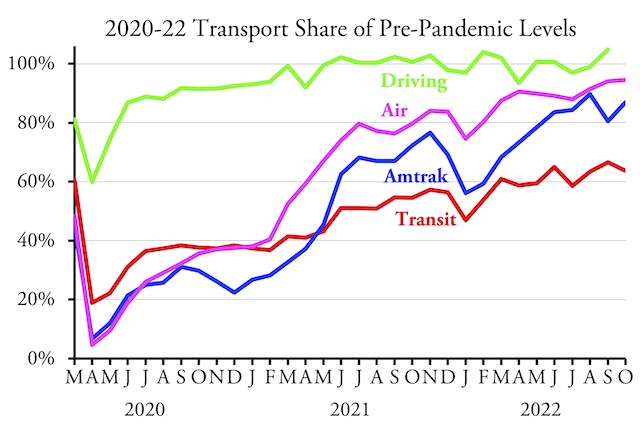Amtrak carried almost 87 percent as many passenger-miles in October 2022 as it did in October 2019, according to the monthly performance report released by the state-owned company yesterday. This is a significant increase from the 80.5 percent recorded in September.
This is an update of a chart posted last week. I’ll provide another update when October driving data are available.
This is still short of the 94.5 percent carried by domestic and international airlines. Domestic air travel alone is even higher, but unfortunately those data are somewhat behind — the latest is for September, when domestic air travel was several percent higher than the average of domestic and international travel.
More curious is the lack of parallels between urban transit ridership and Amtrak. When measured as a share of 2019 numbers, transit declined in July while Amtrak increased; transit grew in September while Amtrak fell; then transit declined and Amtrak grew again in October.
One of the most important variables influencing transit is fuel prices, which began growing in February, peaked in June, and have generally fallen since then. Amtrak ridership may also be influenced by fuel prices but the effect is not as large.
October passenger-miles in the Northeast Corridor were 98.4 percent of October 2019’s, while Amtrak’s long-distance trains carried 94.1 percent as many passenger-miles as in 2019. However, short-distance trains supported by state subsidies carried only 74.5 percent. This suggests that many people who once rode trains for short trips are now driving those trips. For example, Los Angeles-San Diego passenger-miles are down 62 percent and San Francisco-Sacramento passenger-miles are down 45 percent. Other state-supported corridors that have fallen far short of recovery include Philadelphia-Harrisburg (-52%), Washington-Newport News (-41%), Washington-Richmond (-40%), Seattle-Portland-Eugene (-36%), Chicago-Milwaukee (-25%), Washington-Norfolk (-25%), Chicago-Detroit (-21%), and Chicago-St. Louis (-15%).
I suspect the Northeast Corridor is doing best because it is doubly subsidized: first with taxpayer subsidies to Amtrak and second because a large share of its riders can charge the cost to their employers. Long-distance trains are doing well because people who might drive from San Francisco to Sacramento are not going to drive from San Francisco to Denver or Chicago. But states considering spending money beefing up short-distance train service should take into account the nationwide decline in ridership on such trains.








